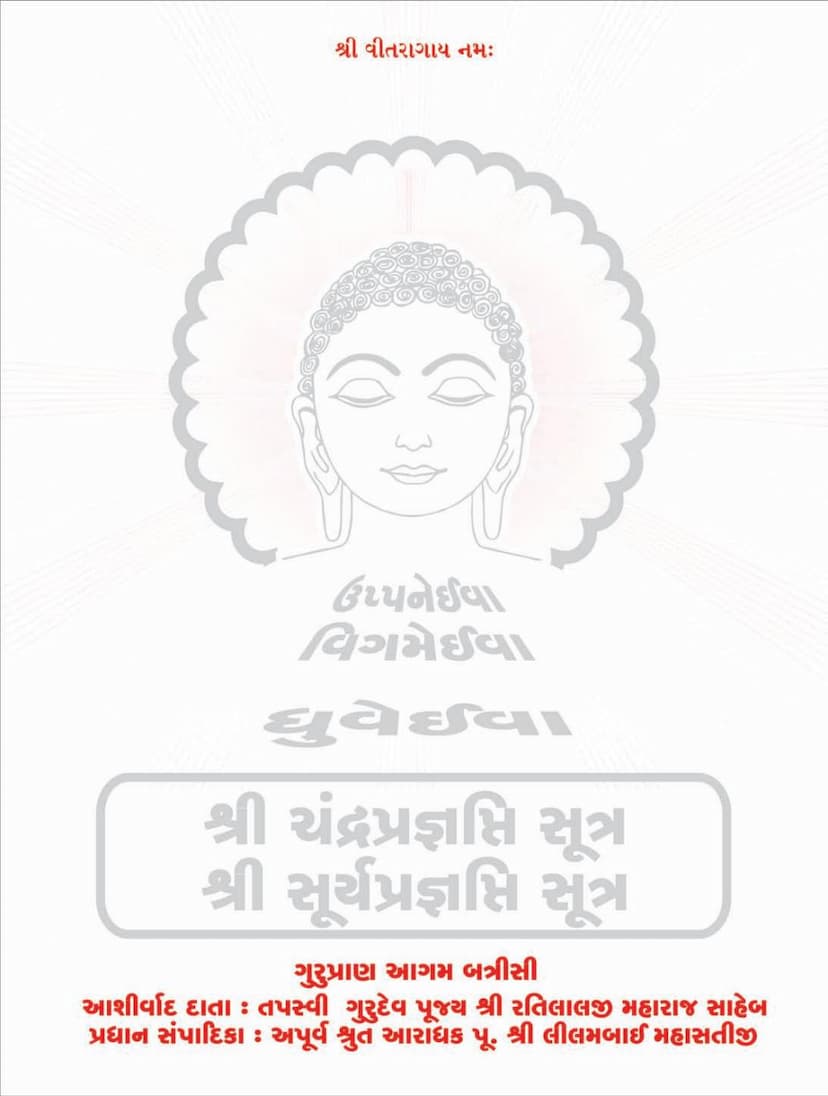Agam 16 17 Chandra Pragnapti Surya Pragnapti Sutra
Added to library: September 1, 2025

Summary
Here's a comprehensive summary of the Jain text "Agam 16 17 Chandra Pragnapti Surya Pragnapti Sutra," based on the provided pages:
Book Title: Agam 16 17 Chandra Pragnapti Surya Pragnapti Sutra Author(s): Rajematibai Mahasati, Artibai Mahasati, Subodhikabai Mahasati Publisher: Guru Pran Prakashan Mumbai Catalog Link: https://jainqq.org/explore/008776/1
This Jain text, specifically focusing on the Chandra Pragnapti Sutra and Surya Pragnapti Sutra, is part of a larger work known as the "Guru Pran Agam Batrisi" (a collection of 32 Agams). The publication is dedicated to the memory of Pujya Shri Pranalalji M. S. and Pujya Shri Ratilalji M. S., commemorating the birth centenary of the former and honoring the memory of the latter.
Core Content and Focus:
The Chandra Pragnapti Sutra and Surya Pragnapti Sutra are Jyotishgannraj Prajnapti Sutras (treatises on celestial bodies and their movements). The primary focus of these sutras is to scientifically and astronomically explain the workings of the cosmos according to Jain cosmology and principles.
Key Themes and Concepts Covered:
-
Cosmic Calculations and Geography: The text delves into intricate calculations related to the celestial bodies. It meticulously details the movements of the sun and moon, their paths through different "mandals" (celestial regions or orbits), and the time taken to traverse them. The text explains concepts like the number of mandals, their distances, shapes, and the time taken by the sun and moon to complete their journeys.
-
Chandra Pragnapti (Lunar Treatise):
- Lunar Cycles and Phases: It explains the lunar calendar, the phases of the moon, and how these phases relate to the passage of time, tithis (lunar days), and the overall measurement of time.
- Lunar Movements: The text describes the moon's specific path through different constellations and its relationship with them.
- Lunar Impact: It touches upon how the moon's position and phases influence terrestrial phenomena, though this is a secondary focus.
-
Surya Pragnapti (Solar Treatise):
- Solar Cycles and Movements: It details the sun's journey through the cosmos, its apparent movement through the ecliptic, and how this movement dictates the seasons and day-night cycles.
- Solar Calculations: The text provides precise calculations for the sun's path, its position relative to celestial bodies, and its influence on time measurement.
- Dual Suns: A significant aspect of Jain cosmology, the text mentions the existence of two suns, explaining their synchronized movements and how they contribute to the cosmic order.
- Solar Influence: It discusses how the sun's rays and heat affect different regions, creating variations in day and night length, and influencing the environment.
-
Time Measurement and Calendars: The sutras are fundamental to understanding the Jain calendar system. They explain the calculation of months, years, epochs (yugas), and the intricate system of time measurement based on celestial movements. The text highlights the meticulous nature of Jain astronomical calculations, differentiating between solar, lunar, and stellar months.
-
Cosmic Entities and Their Forms: The text describes the physical forms and characteristics of celestial bodies like the sun, moon, stars, and planets (referred to as jyotishka devas). It mentions their respective orbits or "mandals" and provides details about their sizes, distances, and the deities associated with them.
-
Different Perspectives (Pratipad): The sutras often present various theories or viewpoints, known as pratipad, from different philosophical schools regarding cosmic phenomena. The text then clarifies the Jain perspective, often refuting or elaborating on these external views based on omniscient knowledge (kevali pragat).
-
Detailed Astronomical Data: The text is rich with quantitative data, providing specific measurements in "yojans" (an ancient Indian unit of distance), details about the number of stars, the length of day and night in different regions, and the speeds of celestial bodies.
-
The Role of Deities: The text acknowledges the presence of deities associated with these celestial bodies, explaining their roles within the cosmic framework and their divine attributes.
-
Methodology and Interpretation: The text emphasizes the importance of understanding the context and intention behind the scriptures. It highlights that the calculations are based on yogic power or spiritual evolution, and interpretations should not be clouded by worldly desires or limited intellect. It also discusses the importance of Agamas as the word of the omniscient Tirthankaras and ganadharas.
-
Dedication and Scholarly Effort: The publication reflects significant scholarly effort by Mahasatijis (Jain nuns) who have translated, interpreted, and compiled the original texts. It acknowledges the spiritual guidance and blessings received from various revered Munis and the financial support from donors. The text also includes biographical sketches of key spiritual figures associated with the Gondal lineage, such as Pujya Shri Dungarsinhji M. S., Pujya Shri Pranalalji M. S., and Pujya Shri Ratalalji M. S., showcasing their contributions to Jainism.
Overall Significance:
The Chandra Pragnapti Sutra and Surya Pragnapti Sutra are crucial for understanding the detailed Jain cosmology. They provide a framework for comprehending the universe's structure, the celestial bodies' movements, and their role in the measurement of time according to Jain philosophy. The publication aims to make this complex knowledge accessible through Gujarati translation, commentary, and appendices, facilitating its study and propagation within the Jain community. The text highlights the scientific and mathematical rigor inherent in ancient Jain scriptures.